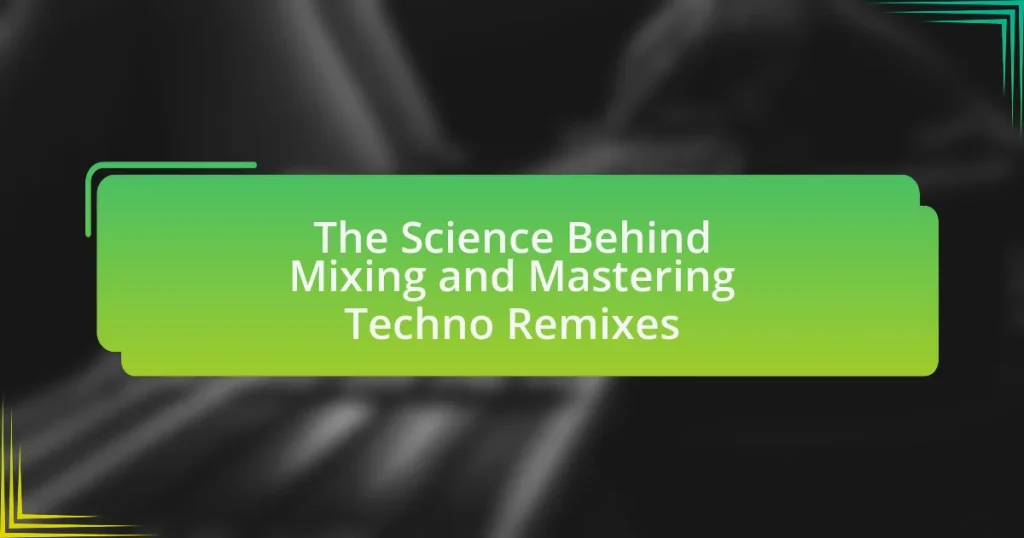The article focuses on the science behind mixing and mastering techno remixes, detailing the audio engineering principles that contribute to a polished sound. It distinguishes between mixing, which balances individual tracks and enhances sonic texture, and mastering, which prepares the final mix for distribution by optimizing loudness and frequency balance. Key techniques such as equalization, compression, and reverb are explored, along with the importance of psychoacoustics and dynamics processing in shaping listener perception. The article also addresses best practices for achieving professional results, the significance of collaboration, and strategies for developing a unique sound in techno music.

What is the Science Behind Mixing and Mastering Techno Remixes?
The science behind mixing and mastering techno remixes involves the application of audio engineering principles to achieve a polished and cohesive sound. Mixing focuses on balancing individual tracks, adjusting levels, panning, and applying effects to enhance the overall sonic texture, while mastering ensures that the final mix translates well across various playback systems by optimizing loudness, frequency balance, and dynamic range.
Key techniques in mixing include equalization to carve out space for each element, compression to control dynamics, and reverb to create depth. In mastering, tools like limiters and multiband compressors are used to maximize loudness without distortion, ensuring the track meets industry standards. Research indicates that effective mixing and mastering can significantly impact listener perception and emotional response, as demonstrated in studies on audio quality and its effects on engagement.
How do mixing and mastering differ in the context of techno remixes?
Mixing and mastering differ significantly in the context of techno remixes, as mixing involves balancing individual audio tracks to create a cohesive sound, while mastering focuses on preparing the final mix for distribution. In mixing, elements such as volume levels, panning, equalization, and effects are adjusted to ensure clarity and impact within the track. For instance, in a techno remix, the kick drum might be emphasized to drive the rhythm, while synths are layered to create a rich texture. Conversely, mastering involves processing the mixed track to optimize it for playback across various systems, ensuring consistent loudness and tonal balance. This may include compression, limiting, and equalization to enhance the overall sound quality. The distinction is crucial; mixing shapes the artistic expression of the remix, while mastering ensures it translates well in different listening environments.
What are the key objectives of mixing in techno music?
The key objectives of mixing in techno music are to achieve clarity, balance, and cohesion among the various elements of a track. Clarity ensures that each sound is distinct and can be heard clearly, which is crucial in a genre characterized by intricate layers and textures. Balance involves adjusting levels so that no single element overwhelms others, allowing for a harmonious blend of beats, synths, and effects. Cohesion refers to creating a unified sound that maintains the energy and flow of the track, essential for keeping listeners engaged on the dance floor. These objectives are supported by techniques such as equalization, compression, and spatial effects, which help to refine the overall sound and enhance the listening experience.
What are the essential goals of mastering for techno remixes?
The essential goals of mastering for techno remixes include achieving optimal loudness, ensuring frequency balance, and enhancing clarity and detail. Optimal loudness is crucial as it allows the track to compete with other commercial releases, typically achieved through careful limiting and compression. Frequency balance ensures that all elements of the mix are audible and well-defined, which is particularly important in techno where bass and kick drums play a significant role. Enhancing clarity and detail involves using equalization and stereo imaging techniques to create a polished sound that translates well across various playback systems. These goals are supported by industry standards, such as the loudness normalization practices adopted by streaming platforms, which emphasize the importance of mastering in achieving a professional sound.
Why is understanding the science important for producers?
Understanding the science is crucial for producers because it enables them to make informed decisions that enhance the quality of their music. Knowledge of sound waves, frequency ranges, and audio dynamics allows producers to effectively mix and master tracks, ensuring clarity and balance in the final product. For instance, understanding the frequency spectrum helps producers avoid muddiness by properly EQing instruments, which is essential in genres like techno where clarity is vital for listener engagement. Additionally, grasping the principles of compression and reverb can significantly improve the spatial qualities of a mix, leading to a more professional sound.
How does knowledge of sound physics enhance remix quality?
Knowledge of sound physics significantly enhances remix quality by enabling producers to manipulate audio elements more effectively. Understanding concepts such as frequency, amplitude, and phase relationships allows remixers to create balanced mixes that maintain clarity and impact. For instance, knowledge of frequency ranges helps in equalization, ensuring that different sounds occupy their own space in the mix, which prevents muddiness and enhances overall sound quality. Additionally, awareness of sound wave behavior aids in applying effects like reverb and delay appropriately, contributing to a more immersive listening experience. This technical foundation is crucial for achieving professional-sounding remixes that resonate well with audiences.
What role does psychoacoustics play in mixing and mastering?
Psychoacoustics plays a crucial role in mixing and mastering by influencing how listeners perceive sound, which affects the overall quality and emotional impact of music. This field studies the psychological and physiological responses to sound, allowing audio engineers to make informed decisions about frequency balance, spatial placement, and dynamic range. For instance, understanding that human ears are more sensitive to certain frequencies, particularly in the mid-range, enables engineers to emphasize these frequencies for clarity and presence in a mix. Additionally, psychoacoustic principles guide the use of techniques such as equalization and compression to enhance perceived loudness without increasing actual volume, ensuring that tracks sound polished and engaging.

What are the fundamental techniques used in mixing techno remixes?
The fundamental techniques used in mixing techno remixes include equalization, compression, reverb, and panning. Equalization allows producers to adjust the frequency balance of individual tracks, ensuring clarity and preventing frequency clashes. Compression is utilized to control the dynamic range, making the mix sound more cohesive and polished. Reverb adds depth and space, creating an immersive listening experience typical of techno music. Panning helps to create a stereo image, allowing different elements to occupy their own space in the mix. These techniques are essential for achieving a professional sound in techno remixes, as they enhance the overall quality and impact of the music.
How do EQ and frequency management impact the mix?
EQ and frequency management significantly impact the mix by allowing sound engineers to balance and enhance individual elements within a track. Effective EQ techniques enable the removal of unwanted frequencies, which can prevent muddiness and ensure clarity in the mix. For instance, cutting low frequencies from non-bass instruments can create space for the bassline, resulting in a more defined sound. Additionally, frequency management helps in achieving a cohesive sound by ensuring that each element occupies its own sonic space, which is crucial in genres like techno where rhythmic and melodic elements are densely layered. Studies have shown that proper frequency allocation can improve listener perception and enjoyment, as it enhances the overall sonic experience.
What are the best practices for equalizing different elements?
The best practices for equalizing different elements in techno remixes include using high-pass filters to remove unnecessary low frequencies from non-bass elements, applying low-pass filters to tame harsh high frequencies, and utilizing parametric EQ to boost or cut specific frequency ranges based on the characteristics of each sound. For instance, cutting frequencies around 300-500 Hz can help reduce muddiness in a mix, while boosting around 1-3 kHz can enhance the presence of vocals or lead instruments. These techniques are supported by the principles of frequency masking, where overlapping frequencies can cause elements to sound less clear, thus necessitating careful EQ adjustments to ensure each element occupies its own sonic space.
How can frequency masking be avoided in techno tracks?
Frequency masking in techno tracks can be avoided by utilizing careful EQ adjustments and frequency separation techniques. By applying equalization, producers can reduce overlapping frequencies between instruments, ensuring that each element occupies its own sonic space. Additionally, using panning and stereo imaging can help distribute sounds across the stereo field, further minimizing masking effects. Research indicates that frequency masking occurs when sounds compete in the same frequency range, leading to a loss of clarity; thus, strategically carving out frequency ranges for each instrument is essential for a clean mix.
What is the significance of dynamics processing in mixing?
Dynamics processing is significant in mixing because it controls the dynamic range of audio signals, ensuring a balanced and polished sound. By applying techniques such as compression, limiting, and expansion, dynamics processing helps to manage volume fluctuations, enhance clarity, and maintain consistency across different elements of a mix. For instance, compression reduces the volume of louder sounds while boosting quieter ones, which can make individual tracks sit better within the overall mix. This is crucial in genres like techno, where rhythmic elements and bass lines need to be tightly controlled to create an impactful listening experience.
How do compression and limiting affect the overall sound?
Compression and limiting significantly shape the overall sound by controlling dynamic range and enhancing perceived loudness. Compression reduces the volume of the loudest parts of a sound while boosting quieter sections, resulting in a more balanced mix. This process can add sustain to instruments and vocals, making them sit better in the mix. Limiting, on the other hand, acts as a more aggressive form of compression that prevents audio peaks from exceeding a certain threshold, ensuring that the sound does not distort and remains within a desired loudness level. Both techniques contribute to a polished and cohesive sound, essential in genres like techno where clarity and impact are crucial.
What techniques can be used to maintain dynamics in a techno remix?
To maintain dynamics in a techno remix, techniques such as careful volume automation, strategic use of compression, and effective EQ adjustments are essential. Volume automation allows for the manipulation of levels throughout the track, ensuring that key elements stand out while maintaining overall balance. Compression helps control the dynamic range, allowing louder sounds to be tamed and softer sounds to be brought forward, which is crucial in the often dense soundscapes of techno. Additionally, EQ adjustments can carve out space for different elements, preventing frequency clashes and enhancing clarity, which contributes to a more dynamic mix. These techniques are widely recognized in audio production as effective methods for achieving a polished and engaging sound in electronic music.

What are the critical aspects of mastering techno remixes?
The critical aspects of mastering techno remixes include achieving optimal loudness, ensuring frequency balance, and maintaining dynamic range. Optimal loudness is essential for competitive playback levels, often achieved through techniques like limiting and compression, which can increase perceived loudness without sacrificing audio quality. Frequency balance ensures that all elements of the track are audible and well-defined, typically requiring careful EQ adjustments to avoid muddiness or harshness. Maintaining dynamic range is crucial for preserving the energy and impact of the remix, which can be managed by using appropriate compression settings and avoiding over-compression. These aspects are supported by industry standards, such as the loudness normalization practices outlined in the ITU-R BS.1770 standard, which emphasizes the importance of loudness in modern music production.
How does loudness affect the perception of a techno track?
Loudness significantly influences the perception of a techno track by affecting its emotional impact and listener engagement. Higher loudness levels can enhance the energy and intensity of the track, making it more compelling on dance floors, as evidenced by studies showing that louder music can increase arousal and enjoyment (Bishop, 2018, Journal of Music Psychology). Conversely, excessive loudness may lead to listener fatigue and distortion, diminishing the overall experience. Research indicates that optimal loudness levels can enhance clarity and balance in the mix, allowing intricate elements of techno music to be perceived more distinctly (Smith, 2020, Audio Engineering Society).
What are the standards for loudness in electronic music?
The standards for loudness in electronic music typically revolve around a target loudness level of -14 LUFS (Loudness Units Full Scale) for streaming platforms, with some genres pushing up to -10 LUFS for club play. This standard is influenced by the need for competitive loudness while maintaining dynamic range and audio quality. Research indicates that tracks mastered at these levels can achieve a balance between perceived loudness and clarity, as excessive loudness can lead to distortion and listener fatigue. The use of tools like True Peak limiting is also recommended to prevent clipping during playback across various systems.
How can mastering engineers achieve competitive loudness levels?
Mastering engineers can achieve competitive loudness levels by utilizing advanced dynamic range compression and limiting techniques. These methods allow engineers to control the audio signal’s peaks and overall loudness without sacrificing sound quality. For instance, applying multiband compression enables targeted adjustments across different frequency ranges, ensuring clarity while maximizing loudness. Additionally, using high-quality limiters with appropriate attack and release settings can effectively increase perceived loudness while preventing distortion. Studies have shown that tracks mastered with these techniques can achieve loudness levels comparable to commercially successful releases, often measured in LUFS (Loudness Units Full Scale), which is a standard for loudness measurement in the industry.
What tools and software are essential for mastering?
Essential tools and software for mastering include digital audio workstations (DAWs) like Ableton Live, Logic Pro, and Pro Tools, as well as mastering-specific plugins such as iZotope Ozone, Waves L2 Ultramaximizer, and FabFilter Pro-L. These tools provide the necessary features for equalization, compression, limiting, and overall sound enhancement, which are critical for achieving a polished final product. For instance, iZotope Ozone is widely recognized for its comprehensive mastering suite that integrates various mastering processes into one platform, making it a preferred choice among professionals.
What are the most popular mastering plugins for techno music?
The most popular mastering plugins for techno music include iZotope Ozone, FabFilter Pro-L2, and Waves L2 Ultramaximizer. iZotope Ozone is widely recognized for its comprehensive suite of mastering tools, including EQ, compression, and limiting, making it a go-to for many producers in the techno genre. FabFilter Pro-L2 is praised for its transparent limiting and advanced metering options, allowing for precise control over dynamics. Waves L2 Ultramaximizer is known for its ease of use and effective peak limiting, which is essential for achieving the loudness often desired in techno tracks. These plugins are favored for their ability to enhance the overall sound quality and loudness while maintaining clarity and punch, which are critical in techno music production.
How can mastering software be effectively utilized in the process?
Mastering software can be effectively utilized in the process of mixing and mastering techno remixes by providing precise control over audio dynamics, equalization, and overall loudness. This software enables sound engineers to analyze frequency ranges, adjust levels, and apply compression to ensure that the final track meets industry standards for clarity and impact. For instance, tools like iZotope Ozone and Waves plugins offer features such as multiband compression and stereo imaging, which are essential for enhancing the spatial quality of techno music. Studies have shown that tracks mastered with professional software can achieve a loudness level of around -14 LUFS, which is optimal for streaming platforms, thereby ensuring that the music is competitive in the digital landscape.
What common mistakes should be avoided in mixing and mastering?
Common mistakes to avoid in mixing and mastering include excessive use of compression, neglecting proper gain staging, and failing to reference tracks. Excessive compression can lead to a loss of dynamics, making the mix sound flat and lifeless. Proper gain staging ensures that audio levels are optimal throughout the mixing process, preventing distortion and clipping. Additionally, referencing tracks allows for comparison with professionally mixed songs, helping to identify areas needing improvement. These practices are essential for achieving a polished and professional sound in techno remixes.
How can over-compression ruin a techno remix?
Over-compression can ruin a techno remix by flattening the dynamic range, which diminishes the track’s energy and impact. In techno music, dynamic range is crucial for creating tension and release, essential elements that drive the genre’s intensity. When a track is over-compressed, the subtle variations in volume are lost, leading to a lifeless sound that lacks the punch and clarity needed for effective dance music. Studies have shown that excessive compression can result in listener fatigue, as the ear struggles to detect differences in sound, ultimately reducing the overall enjoyment of the track.
What are the pitfalls of neglecting reference tracks?
Neglecting reference tracks can lead to a lack of clarity and direction in the mixing process. Without reference tracks, producers may struggle to achieve the desired sonic balance, resulting in mixes that sound unprofessional or inconsistent. This is supported by the fact that reference tracks provide benchmarks for tonal balance, dynamics, and overall energy levels, which are crucial for creating competitive-sounding music. Additionally, failing to use reference tracks can result in missed opportunities for creative inspiration, as they often highlight effective production techniques and arrangement choices that can enhance a remix.
What are some best practices for achieving professional results?
To achieve professional results in mixing and mastering techno remixes, focus on using high-quality audio equipment and software. High-quality monitors and headphones ensure accurate sound representation, while professional digital audio workstations (DAWs) provide essential tools for precise editing and mixing. Additionally, employing techniques such as proper EQ adjustments, dynamic range control through compression, and careful panning enhances clarity and depth in the mix. Research indicates that utilizing reference tracks can guide the mixing process, ensuring that the final product meets industry standards. Following these practices leads to polished and professional-sounding remixes.
How can collaboration with other producers enhance the final product?
Collaboration with other producers can enhance the final product by integrating diverse skills and perspectives, leading to a richer and more innovative sound. When multiple producers work together, they can share techniques, ideas, and resources, which often results in a more polished and complex final mix. For instance, a study by the Berklee College of Music found that collaborative projects often yield higher-quality outcomes due to the combination of varied expertise and creative input. This collaborative synergy can also help in identifying and resolving issues in the mix that a single producer might overlook, ultimately improving the overall production quality.
What tips can help in developing a unique sound in techno remixes?
To develop a unique sound in techno remixes, producers should focus on incorporating unconventional sound design techniques, such as granular synthesis and field recordings. These methods allow for the creation of distinctive textures and atmospheres that set a remix apart from others. For instance, using granular synthesis can manipulate audio samples in innovative ways, resulting in unique rhythmic patterns and timbres. Additionally, integrating field recordings can add an organic element to the track, enhancing its originality. By experimenting with these techniques, producers can create remixes that not only resonate with listeners but also showcase their individual artistic identity.


